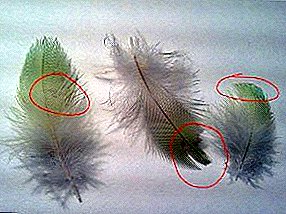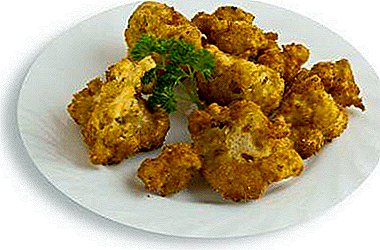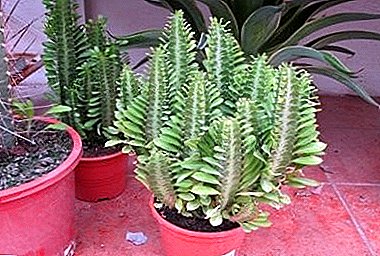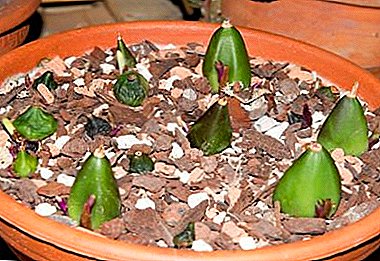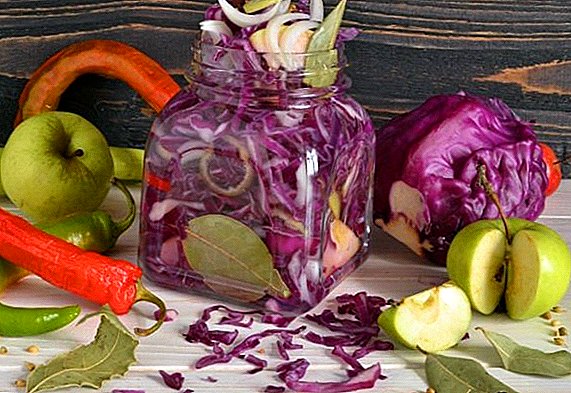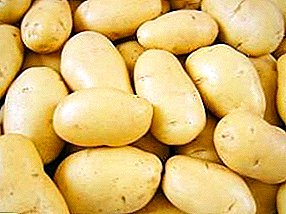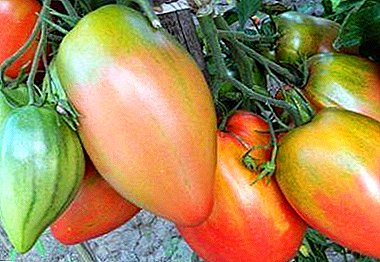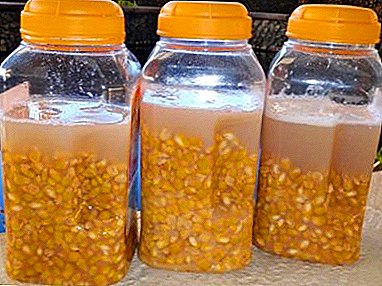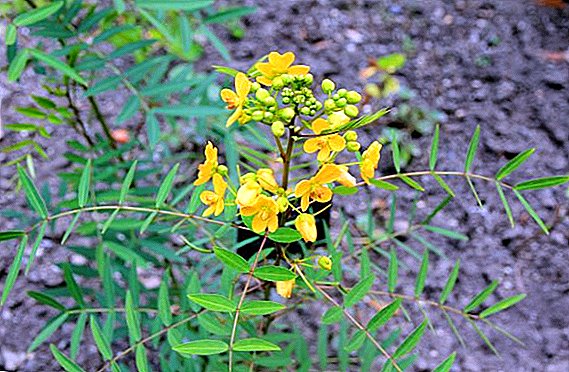 Alexandria sheet is also known under the names of African Cassia, Holm Cassia, Egyptian Senna. The plant is used in folk and traditional medicine, so some countries are specially engaged in its cultivation as a medicinal raw material.
Alexandria sheet is also known under the names of African Cassia, Holm Cassia, Egyptian Senna. The plant is used in folk and traditional medicine, so some countries are specially engaged in its cultivation as a medicinal raw material.
Botanical description
Before us is a shrub belonging to the legume family. It is a small sprawling plant, which in nature grows no more than 1 m in height, and during cultivation it can reach 2 meters.
Senna has a taproot on which a small number of side roots are formed. The root system is quite long, which allows the plant to obtain moisture at a considerable depth. 
Did you know? Title "Senna" is of Arabic origin, it is the most ancient, and the plant "Egyptian" received it in Russia, since it was imported from this African state.As for the stem, it is upright, has a large number of shoots, because of which it forms a thick bush. The branches are arranged alternately, they form small, pointed ovoid leaves.
Since the plant belongs to the legume, the fruit is a multi-seed bean, which has a length of about 5.5 cm. It is painted brown.
Collection and storage
In nature, shrubs can be found exclusively in African and Asian deserts. It is cultivated in India, Pakistan, Kazakhstan and Turkmenistan.
If valuable raw materials cannot be collected, it means that you need to grow it yourself. The shrub is propagated by seeds, which are pre-soaked, and then planted in late spring.
The legume family includes both valuable economic, technical, fodder, and very decorative, even poisonous plants - chickpeas, soybeans, clover, clitoris, black beans, red, white, asparagus, peas, sweet peas, dolichos, broomsticks, legumes, peanuts, beans, mouse peas, acacia, chertsis, vetch, lupine, alfalfa.
 For medicinal purposes, both leaves and fruits are used. In this case, preference is given to sheet plates, since the spectrum of their application is wider. The collection of leaves begins at the moment when they are fully formed.
For medicinal purposes, both leaves and fruits are used. In this case, preference is given to sheet plates, since the spectrum of their application is wider. The collection of leaves begins at the moment when they are fully formed.It does not make sense to collect young leaves, as they contain less of the substances we need. Fruits should also be harvested after full maturity, when they turn dark brown.
Dry the raw materials exclusively under canopies that are well ventilated. During drying, you need to regularly flip the leaf plates so that they dry out faster and also do not start to scream.
It is better to store dried leaves and fruits in paper or cloth bags, but it should be remembered that the product should not get moisture, so this storage option is acceptable only if the room is kept at low humidity. If this cannot be achieved, then use glass jars with silicone lids.
Important! The shelf life of the dry product is 2 years.

Beneficial features
If it seems to you that cucumber with milk is a strong laxative, then you did not use senna leaves, which are part of many laxative preparations. Fruits are also not devoid of this property, but it is not as strong as that of leaf plates.
The point is that when released into the intestine, the substances contained in the foliage and fruits irritate the mucous membrane, which is why such an effect occurs.
In a small amount, the product improves digestion and also causes appetite. In eastern medicine, senna is used to treat conjunctivitis, glaucoma, and skin diseases. In official medicine, it is also prescribed in its pure form with anal fissures or hemorrhoids.
The blackthorn, avran medicinal, fig, almond, pumpkin, sedge, laconosa, laminaria, beet, guar gum, horse sorrel, beet tops, stems of purple, gooseberry, agave, milkweed have a laxative effect.The plant is part of the majority of fees for weight loss. This is due to the fact that the product removes all fecal matter from the body, and also removes toxins. Such an action helps the digestive system to organize its work, after which the metabolism is accelerated, and excess weight gradually disappears.
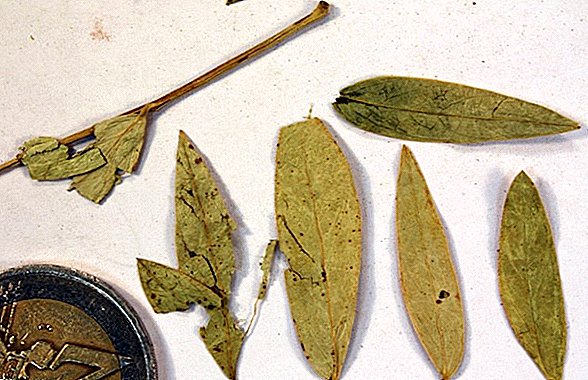
Use in traditional medicine
Below are a few recipes for remedies used for a particular ailment. We strongly recommend sticking to the formulation and dosage.
Treatment of gout, joint pain, epilepsy, headaches
For this recipe, you need to take fresh leaves (200 g), then grind them and pour 1 liter of Cahors, or use similar red wine. The mixture is poured into a suitable vessel, after which it is placed in a dark place for 20 days. Shake the vessel once a week.
After 3 weeks, the mixture is filtered and poured into a convenient container. Should take 50 g three times a day half an hour before meals. If you have problems with the stomach, then be sure to first consult your doctor.
Important! It is necessary to use the wine, not the wine drink. This difference is indicated on the label.
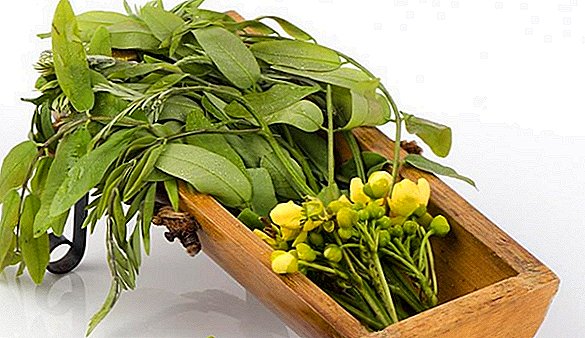
With chronic constipation
Consider the simplest option that does not require additional time. Take 1 tbsp. l without a hill of well-crushed dry or fresh leaves, pour 200 ml of boiled water at room temperature, then leave for 8-10 hours to infuse.
After that we filter and drink all the volume. If the problem with constipation is not solved, then the technique is repeated again.
Laxative tea
For making tea you need a lot of ingredients, so if you need a laxative, then it is better to use the previous recipe.
We take senna leaves, buckthorn bark, Zhoster berries, anise fruits and licorice root in a ratio of 3: 2: 2: 1: 1. Fill the mixture with boiling water, and then insist a few minutes. It is advisable to use tea slightly warm or cold, so as not to cause spasms.
Did you know? In ancient times, senna was used in sacrifices and incenses to the gods.

Atherosclerosis Treatment
In this case, herbal collection is used, it requires cinnamon rose hips, dried marsh, hung birch leaves, peppermint, seeds of sown carrots, Eleutherococcus prickly roots, senna fruits or leaves, kidney tea, roots of large burdock.
For the infusion, 15 mg of wild rose, 10 mg of dried cumin, birch, peppermint and carrot are taken. 15 mg of Eleutherococcus is added, as well as 10 mg of senna, kidney tea, and burdock. All this composition is filled with a liter of water and infused day. Filter and take 1/3 cup (200 ml) three times a day after meals.
Spastic Colitis Treatment
For the present you need the following:
- pharmacy chamomile;
- fennel fruits;
- caraway fruit;
- alder seedlings;
- peppermint;
- Althea roots;
- Hypericum grass;
- plantain leaves;
- flowers of immortelle sandy;
- senna leaves or fruits.

Slimming
To prepare an infusion for weight loss is very simple. It is enough to take a tablespoon of chopped herbs, pour 200 ml of boiling water, and then insist about 4 hours. Next, you need to strain and cool the drink.
Should be taken in small sips before bedtime. If a laxative effect is clearly manifested, the dose should be reduced.
Important! This tool has a choleretic effect.
Contraindications
It is forbidden to use any drugs based on this plant for pregnant women, as well as nursing mothers. The same applies to people who often have diarrhea, or have been diagnosed with acute bowel disease. Also, if there is an allergy, senna is prohibited in any form.
Now you know what Senna Alexandria is. Remember that the abuse of laxatives on the basis of senna is addictive, resulting in atrophy of the intestinal muscles. As a result, without such means, you can not empty your bowels.
Video: Senna Experience

Actually, why laxatives are forbidden during pregnancy - they cause spasms of the intestines and, accordingly, contractions of the muscles of the uterus, and what this all leads to.
For example, neither dried apricots, nor prunes, nor kiwi, nor kefir, vegetable oil on an empty stomach, from herbal products - nothing at all, helps me. It remains probably only to try the milk with cucumbers))). And of the allowed ones - duphalac and forlax, well, they are so disgusting to taste, and in my case they help me with such difficulty ... only if duphalac has two doses, then maybe))).
Girls, if you can, save yourself with herbal remedies, regulate nutrition. This is much better, and perhaps everything will normalize with time. I have had problems since birth (my mother told me) and now it’s useless to do something.





